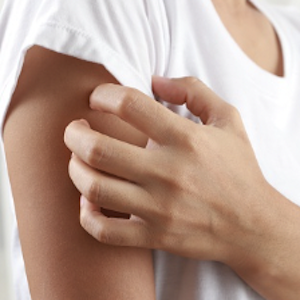Efficacy of autologous serum therapy in positive and negative autologous serum skin test patients in chronic urticaria in a tertiary care centre

Accepted: 30 June 2022
HTML: 25
All claims expressed in this article are solely those of the authors and do not necessarily represent those of their affiliated organizations, or those of the publisher, the editors and the reviewers. Any product that may be evaluated in this article or claim that may be made by its manufacturer is not guaranteed or endorsed by the publisher.
Autologous serum therapy (AST) has been a recent therapeutic choice for a variety of chronic diseases such as allergic, inflammatory, infectious, and autoimmune disorders. However, evidence were not convincing of the beneficial effects of autologous serum therapy in treatment of Chronic urticaria (CU). CU is a common dermatological condition that is very disturbing to the patient as well as to the physician. A new observation was made about the abnormal type 1 reactions to intradermal autologous serum injections in some CU patients. This has led to the new subgroup of autoimmune chronic urticaria. The autologous serum skin test (ASST) is an intradermal test result in immediate hypersensitivitytype skin reactions in a subpopulation of CU patients and it’s giving promising evidence of therapeutic and diagnostic benefit. Autologous whole blood injection has already been used as one of the old treatment modalities for chronic urticaria. The objectives of this study/reasearch are to analyse the efficacy of autologous serum therapy in patients with chronic urticaria and compare its results in ASST(+) and ASST(-) chronic urticaria patients. Approximately 5 mL of patients’ blood was drawn in a plain vacutainer and centrifuged at 3000 r.p.m. for 10 min, separated 2.5 mL serum injected deep intramuscularly into gluteus muscle. Injections were repeated every week for about 9 weeks and a repeat follow up at 20 weeks was done. Out of a total of 20 patients, excellent improvement in terms of decrease in Urticaria assessment severity score was seen in 6 patients; whereas, 10 patients showed partial response, 2 patients showed no response and 2 patients lost the follow up. 10 patients with ASST(+) and 6 patients of ASST(-) showed little improvement in urticaria severity score. AST therapy is a cost-effective adjuvant modality to reduce the severity of symptoms of chronic urticaria. In some patients it’s giving long term remission period and it decreases the updosing of antihistamines.
Kaplan AP, Greaves M. Pathogenesis of chronic urticaria. Clin Exp Allergy 2009; 39:777-87.
Hide M, Francis DM, Grattan CE, et al. Autoantibodies against the high affinity IgE receptor as a cause of histamine release in chronic urticaria. N Engl J Med 1993;328:1599-604
Godse KV. Autologous serum skin test in chronic idiopathic urticaria. Indian J Dermatol Venereol Leprol 2004;70: 283-4.
Fiebiger E, Maurer D, Holub H, et al. Serum IgG autoantibodies directed against the alpha chain of Fc epsilon RI: A selective marker and pathogenetic factor for a distinct subset of chronic urticaria patients? J Clin Invest 1995;96:2606-12.
Ferrer M, Kinet JP, Kaplan AP. Comparative studies of functional and binding assays for IgG anti Fc epsilon Riα (α-subunit) in chronic urticaria. J Allergy Clin Immunol 1998;101:672-6.
Piconi S, Trabattoni D, Iemoli E, et al. Immune profiles of patients with chronic idiopathic urticaria. Int Arch Allergy Immunol 2002;128:59-66.
Kaplan AP. Urticaria and Angioedema. In: Wolff K, Goldsmith LA, Katz SI, et al., eds. Dermatology in General Medicine. 7th ed. New York: McGraw-Hill; 2008. pp 330-43.
Sabroe RA, Grattan CE, Francis DM, et al. The autologous serum skin test: a screening test for autoantibodies in chronic idiopathic urticaria. Br J Dermatol 1999;140:446-52
Asero R, Tedeschi A, Lorini M, et al. Chronic urticaria: novel clinical and serological aspects. Clin Exp Allergy 2001;31:1105-1110, 2001.
Konstantinou GN, Asero R, Maurer M, et al. EAACI/GA2LEN task force consensus report: the autologous serum skin test in urticaria. Allergy 2009;64:1256-68.
Grattan CE, Humphreys F. Guidelines for evaluation and management of urticaria in adults and children. Br J Dermatol 2007; 157:1116-23.
Behl PN. Practice of Dermatology. 7th edition. New Delhi: Oxford Blackwell Scientific publications; 1990. Autohaemotherapy; p. 76.
Staubach P, Onnen K, Vonend A, et al. Autologous whole blood injections to patients with chronic urticaria and a positive autologous serum skin test: a placebo-controlled trial. Dermatology 2006;212:150–9.
Bajaj AK, Saraswat A, Upadhyay A, et al. Autologous serum therapy in chronic urticaria: old wine in a new bottle. Indian J Dermatol Venereol Leprol 2008;74:109–13.
Maurer M. Chronic urticaria, Chapter 5.2. Urticaria and angioedema. In: Zuberbier T, Grattan C, Maurer M., Eds. New York: Springer International 2010.pp. 45–54.
Patil S, Sharma N, Godse K. Autologous serum therapy in chronic urticaria. Indian J Dermatol 2013;58: 225-6
Schoepke N, Doumoulakis G, Maurer M. Diagnosis of urticaria. Indian J Dermatol 2013;58: 211-8
Grattan CE, Sabroe RA, Greaves MW. Chronic urticaria. J AmAcad Dermatol 2002;46:645-57.
Zuberbier T, Asero R, Bindslev-Jensen C, et al. EAACI/GA2LEN/EDF/WAO guideline: Management of urticaria. Allergy 2009;64:1427-43.
Zuberbier T, Bindslev-Jensen C, Canonica W, et al.: EAACI/GA2LEN/EDF guideline: definition, classification and diagnosis of urticaria. Allergy 2006;6:316-20.
Kolkhir P, Altrichter S, Munoz M, et al. New treatments for chronic urticaria. Ann Allergy Asthma Immunol. 2020;124:2-12.
Wedi B. Emerging treatments for chronic urticaria. Expert Opin Investig Drugs. 2022;31:281-90.
Metz M, Vadasz Z, Kocatürk E, Giménez-Arnau AM. Omalizumab updosing in chronic spontaneous urticaria: an overview of real-world evidence. Clin Rev Allergy Immunol 202;59:38-45.
Copyright (c) 2022 the Author(s)

This work is licensed under a Creative Commons Attribution-NonCommercial 4.0 International License.
PAGEPress has chosen to apply the Creative Commons Attribution NonCommercial 4.0 International License (CC BY-NC 4.0) to all manuscripts to be published.





 https://doi.org/10.4081/dr.2022.9525
https://doi.org/10.4081/dr.2022.9525



